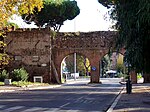San Cesareo de Appia
17th-century Roman Catholic church buildings in ItalyChurches of Rome (rione Celio)Titular churches

San Cesareo in Palatio or San Caesareo de Appia [san tʃeˈzaːreo de ˈappja] is a titular church in Rome, near the beginning of the Appian Way. It is dedicated to Saint Caesarius of Terracina, a 2nd-century deacon and martyr.
Excerpt from the Wikipedia article San Cesareo de Appia (License: CC BY-SA 3.0, Authors, Images).San Cesareo de Appia
Via di Porta San Sebastiano, Rome Municipio Roma I
Geographical coordinates (GPS) Address External links Nearby Places Show on map
Geographical coordinates (GPS)
| Latitude | Longitude |
|---|---|
| N 41.878677777778 ° | E 12.497116666667 ° |
Address
Chiesa di San Cesareo de Appia (Chiesa di San Cesareo in Palatio)
Via di Porta San Sebastiano
00183 Rome, Municipio Roma I
Lazio, Italy
Open on Google Maps










